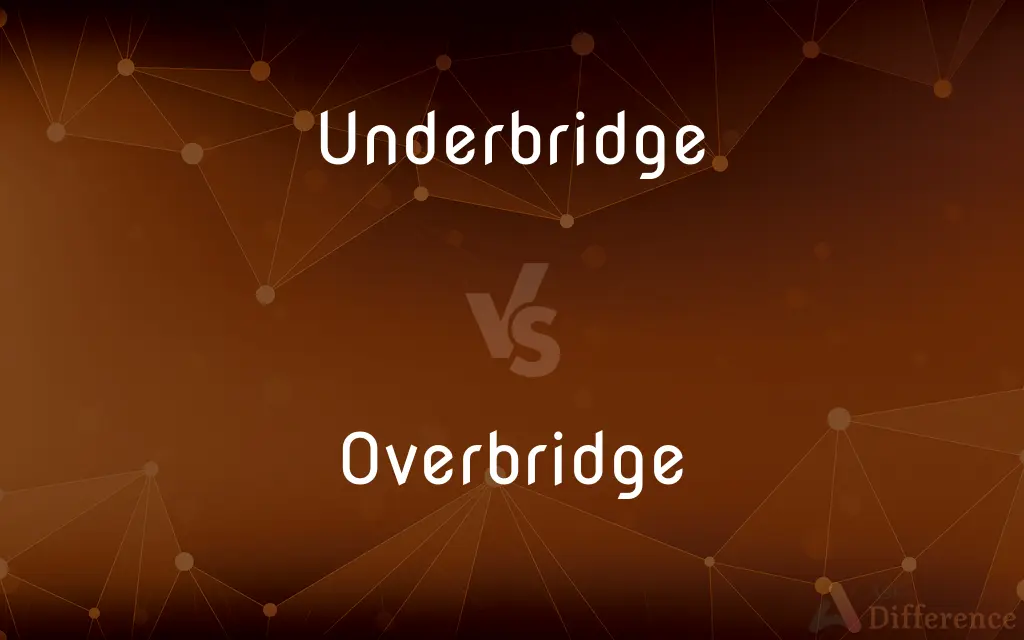Underbridge vs. Overbridge — What's the Difference?
By Tayyaba Rehman & Fiza Rafique — Updated on March 10, 2024
Underbridge refers to a passage beneath a bridge, while Overbridge denotes a bridge that crosses over a road or railway.

Difference Between Underbridge and Overbridge
Table of Contents
ADVERTISEMENT
Key Differences
An underbridge is typically designed to allow vehicles, pedestrians, or animals to pass under a railway or road, facilitating safe crossings without interrupting traffic flow. Overbridge, on the other hand, is constructed to carry traffic over obstacles like roads, railways, or rivers, ensuring uninterrupted movement above these barriers.
Underbridges are crucial in areas where space constraints or geographical features prevent the construction of at-grade crossings, providing a solution that minimizes land use and environmental impact. Conversely, overbridges are often employed in urban and suburban areas to alleviate traffic congestion, allowing for the segregation of different traffic flows and enhancing safety.
The construction of an underbridge requires careful consideration of structural integrity, water drainage, and the maintenance of clearance for the vehicles or trains above, often resulting in complex engineering solutions. Overbridges, however, focus on load-bearing capacity and stability to support the weight of traffic, requiring robust design and materials to ensure longevity and safety.
Underbridges offer a discreet way to maintain connectivity in a landscape, preserving the aesthetic and functional aspects of the environment. Overbridges, while more visible, provide panoramic views and significant landmarks within a region, contributing to both the functionality and skyline of an area.
Comparison Chart
Definition
A passage that goes beneath a bridge, allowing movement underneath.
A bridge that crosses over obstacles like roads or railways.
ADVERTISEMENT
Purpose
To facilitate crossings without interrupting the traffic above.
To carry traffic over obstacles, ensuring uninterrupted flow.
Location
Often found under railways or roads.
Commonly built over roads, railways, or rivers.
Engineering Focus
Structural integrity, drainage, and clearance.
Load-bearing capacity, stability, and durability.
Environmental Impact
Minimizes land use and blends with surroundings.
Can be significant but offers solutions to congestion and safety.
Compare with Definitions
Underbridge
Often used in wildlife conservation to connect habitats.
The new underbridge helps deer cross safely.
Overbridge
Offers a solution to traffic congestion in urban areas.
The new overbridge significantly reduced travel time.
Underbridge
Can be susceptible to flooding during heavy rains.
The underbridge flooded, making it impassable.
Overbridge
Can become iconic landmarks in a city's skyline.
The overbridge is a well-known landmark visible from miles away.
Underbridge
Requires regular inspection to ensure structural safety.
The underbridge underwent a thorough inspection last month.
Overbridge
A bridge designed to carry traffic over an obstacle.
The overbridge eased the commute across the river.
Underbridge
A structure allowing passage beneath a roadway or railway.
The underbridge was a safe path for the cyclists.
Overbridge
Requires maintenance to ensure safety and longevity.
The overbridge received a new coat of paint as part of its maintenance.
Underbridge
Provides a discreet crossing option in dense areas.
The underbridge was a quiet escape from the busy road above.
Overbridge
Enhances connectivity and accessibility in a region.
The overbridge connected two previously isolated neighborhoods.
Underbridge
(British) A bridge that allows traffic to pass under a road, river, railway etc.
Overbridge
(British) A bridge that allows traffic to pass over a road, river, railway etc.
Underbridge
The underneath of a bridge.
Overbridge
(transitive) To form a bridge over; to overarch.
Common Curiosities
What factors influence the design of an overbridge?
Factors include the weight of traffic, environmental conditions, and the nature of the obstacle being crossed.
What is the primary purpose of an underbridge?
To provide a safe crossing beneath a road or railway without disrupting traffic above.
Can underbridges be used by both pedestrians and vehicles?
Yes, underbridges can be designed for pedestrians, vehicles, or both, depending on the need.
Are there any specific safety features for underbridges?
Safety features can include lighting, drainage systems, and barriers to protect pedestrians and vehicles.
What role do underbridges play in wildlife conservation?
They help connect fragmented habitats, allowing safe passage for wildlife and preserving biodiversity.
How do overbridges impact urban development?
They can stimulate growth by improving accessibility and connectivity, encouraging economic development.
How does an overbridge contribute to traffic management?
It separates different flows of traffic, reducing congestion and enhancing safety.
What are the maintenance challenges for underbridges?
Challenges include ensuring structural integrity, preventing water accumulation, and maintaining clearance.
How is the load capacity of an overbridge determined?
It's based on anticipated traffic volumes, types of vehicles, and safety margins.
Are underbridges common in rural areas?
Yes, especially for wildlife crossings or where natural features like streams intersect with roads or railways.
Can overbridges have pedestrian walkways?
Yes, many overbridges include designated walkways for pedestrian safety and convenience.
What environmental considerations are taken into account for underbridges?
Considerations include minimizing land use, preserving natural habitats, and ensuring ecological connectivity.
Can underbridges be part of recreational trails?
Yes, they are often incorporated into bike paths or walking trails to provide safe crossings in scenic areas.
How do overbridges affect a region's aesthetics?
Their design can enhance the visual appeal, with some becoming iconic structures that define a city's identity.
How are overbridges integrated into existing transportation networks?
They are planned as part of broader infrastructure developments, considering current and future traffic demands.
Share Your Discovery

Previous Comparison
Hutzpah vs. Chutzpah
Next Comparison
Sheath vs. SheafAuthor Spotlight
Written by
Tayyaba RehmanTayyaba Rehman is a distinguished writer, currently serving as a primary contributor to askdifference.com. As a researcher in semantics and etymology, Tayyaba's passion for the complexity of languages and their distinctions has found a perfect home on the platform. Tayyaba delves into the intricacies of language, distinguishing between commonly confused words and phrases, thereby providing clarity for readers worldwide.
Co-written by
Fiza RafiqueFiza Rafique is a skilled content writer at AskDifference.com, where she meticulously refines and enhances written pieces. Drawing from her vast editorial expertise, Fiza ensures clarity, accuracy, and precision in every article. Passionate about language, she continually seeks to elevate the quality of content for readers worldwide.
















































